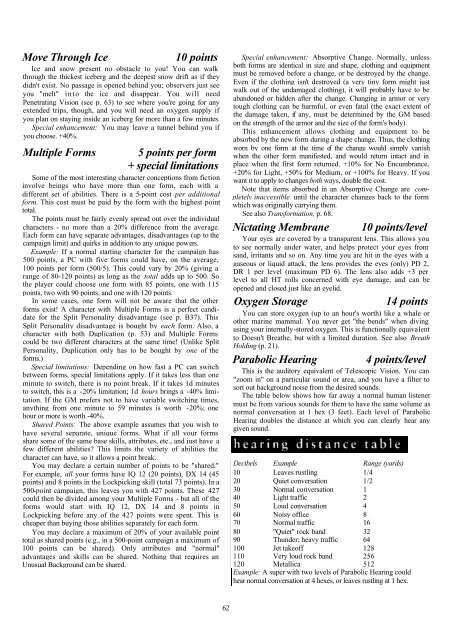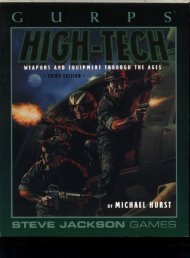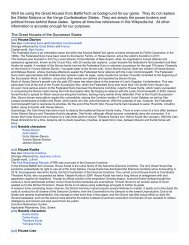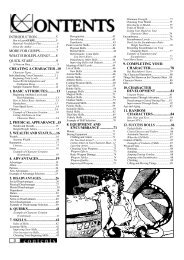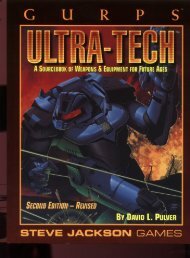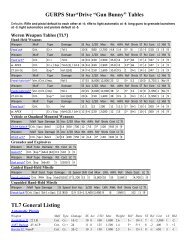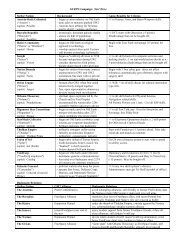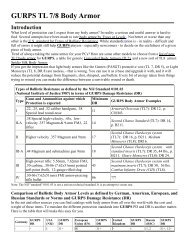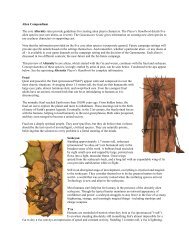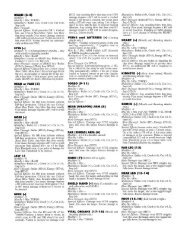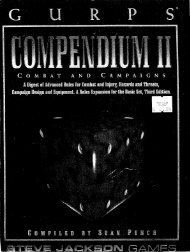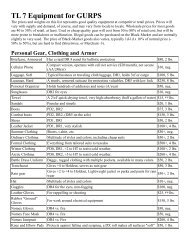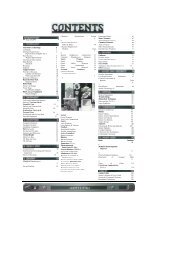GURPS - Compendium 1..
GURPS - Compendium 1..
GURPS - Compendium 1..
You also want an ePaper? Increase the reach of your titles
YUMPU automatically turns print PDFs into web optimized ePapers that Google loves.
Move Through Ice<br />
10 points<br />
Ice and snow present no obstacle to you! You can walk<br />
through the thickest iceberg and the deepest snow drift as if they<br />
didn't exist. No passage is opened behind you; observers just see<br />
you "melt" into the ice and disappear. You will need<br />
Penetrating Vision (see p. 63) to see where you're going for any<br />
extended trips, though, and you will need an oxygen supply if<br />
you plan on staying inside an iceberg for more than a few minutes.<br />
Special enhancement: You may leave a tunnel behind you if<br />
you choose. +40%.<br />
Multiple Forms 5 points per form<br />
+ special limitations<br />
Some of the most interesting character conceptions from fiction<br />
involve beings who have more than one form, each with a<br />
different set of abilities. There is a 5-point cost per additional<br />
form. This cost must be paid by the form with the highest point<br />
total.<br />
The points must be fairly evenly spread out over the individual<br />
characters - no more than a 20% difference from the average.<br />
Each form can have separate advantages, disadvantages (up to the<br />
campaign limit) and quirks in addition to any unique powers.<br />
Example: If a normal starting character for the campaign has<br />
500 points, a PC with five forms could have, on the average,<br />
100 points per form (500/5). This could vary by 20% (giving a<br />
range of 80-120 points) as long as the total adds up to 500. So<br />
the player could choose one form with 85 points, one with 115<br />
points, two with 90 points, and one with 120 points.<br />
In some cases, one form will not be aware that the other<br />
forms exist! A character with Multiple Forms is a perfect candidate<br />
for the Split Personality disadvantage (see p. B37). This<br />
Split Personality disadvantage is bought by each form. Also, a<br />
character with both Duplication (p. 53) and Multiple Forms<br />
could be two different characters at the same time! (Unlike Split<br />
Personality, Duplication only has to be bought by one of the<br />
forms.)<br />
Special limitations: Depending on how fast a PC can switch<br />
between forms, special limitations apply. If it takes less than one<br />
minute to switch, there is no point break. If it takes 1d minutes<br />
to switch, this is a -20% limitation; 1d hours brings a -40% limitation.<br />
If the GM prefers not to have variable switching times,<br />
anything from one minute to 59 minutes is worth -20%; one<br />
hour or more is worth -40%.<br />
Shared Points: The above example assumes that you wish to<br />
have several separate, unique forms. What if all your forms<br />
share some of the same base skills, attributes, etc., and just have a<br />
few different abilities? This limits the variety of abilities the<br />
character can have, so it allows a point break.<br />
You may declare a certain number of points to be "shared."<br />
For example, all your forms have IQ 12 (20 points), DX 14 (45<br />
points) and 8 points in the Lockpicking skill (total 73 points). In a<br />
500-point campaign, this leaves you with 427 points. These 427<br />
could then be divided among your Multiple Forms - but all of the<br />
forms would start with IQ 12, DX 14 and 8 points in<br />
Lockpicking before any of the 427 points were spent. This is<br />
cheaper than buying those abilities separately for each form.<br />
You may declare a maximum of 20% of your available point<br />
total as shared points (e.g., in a 500-point campaign a maximum of<br />
100 points can be shared). Only attributes and "normal"<br />
advantages and skills can be shared. Nothing that requires an<br />
Unusual Background can be shared.<br />
Special enhancement: Absorptive Change. Normally, unless<br />
both forms are identical in size and shape, clothing and equipment<br />
must be removed before a change, or be destroyed by the change.<br />
Even if the clothing isn't destroyed (a very tiny form might just<br />
walk out of the undamaged clothing), it will probably have to be<br />
abandoned or hidden after the change. Changing in armor or very<br />
tough clothing can be harmful, or even fatal (the exact extent of<br />
the damage taken, if any, must be determined by the GM based<br />
on the strength of the armor and the size of the form's body).<br />
This enhancement allows clothing and equipment to be<br />
absorbed by the new form during a shape change. Thus, the clothing<br />
worn by one form at the time of the change would simply vanish<br />
when the other form manifested, and would return intact and in<br />
place when the first form returned. +10% for No Encumbrance,<br />
+20% for Light, +50% for Medium, or +100% for Heavy. If you<br />
want it to apply to changes both ways, double the cost.<br />
Note that items absorbed in an Absorptive Change are completely<br />
inaccessible until the character changes back to the form<br />
which was originally carrying them.<br />
See also Transformation, p. 68.<br />
Nictating Membrane<br />
10 points/level<br />
Your eyes are covered by a transparent lens. This allows you<br />
to see normally under water, and helps protect your eyes from<br />
sand, irritants and so on. Any time you are hit in the eyes with a<br />
gaseous or liquid attack, the lens provides the eyes (only) PD 2,<br />
DR 1 per level (maximum PD 6). The lens also adds +3 per<br />
level to all HT rolls concerned with eye damage, and can be<br />
opened and closed just like an eyelid.<br />
Oxygen Storage<br />
14 points<br />
You can store oxygen (up to an hour's worth) like a whale or<br />
other marine mammal. You never get "the bends" when diving<br />
using your internally-stored oxygen. This is functionally equivalent<br />
to Doesn't Breathe, but with a limited duration. See also Breath<br />
Holding (p. 21).<br />
Parabolic Hearing<br />
4 points/level<br />
This is the auditory equivalent of Telescopic Vision. You can<br />
"zoom in" on a particular sound or area, and you have a filter to<br />
sort out background noise from the desired sounds.<br />
The table below shows how far away a normal human listener<br />
must be from various sounds for them to have the same volume as<br />
normal conversation at 1 hex (3 feet). Each level of Parabolic<br />
Hearing doubles the distance at which you can clearly hear any<br />
given sound.<br />
Decibels Example Range (yards)<br />
10 Leaves rustling 1/4<br />
20 Quiet conversation 1/2<br />
30 Normal conversation 1<br />
40 Light traffic 2<br />
50 Loud conversation 4<br />
60 Noisy office 8<br />
70 Normal traffic 16<br />
80 "Quiet" rock band 32<br />
90 Thunder; heavy traffic 64<br />
100 Jet takeoff 128<br />
110 Very loud rock band 256<br />
120 Metallica 512<br />
Example: A super with two levels of Parabolic Hearing could<br />
hear normal conversation at 4 hexes, or leaves rustling at 1 hex.<br />
62


